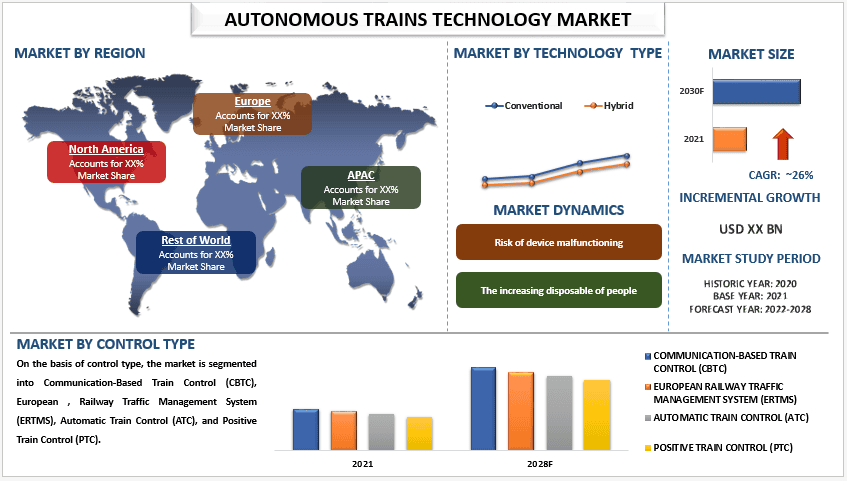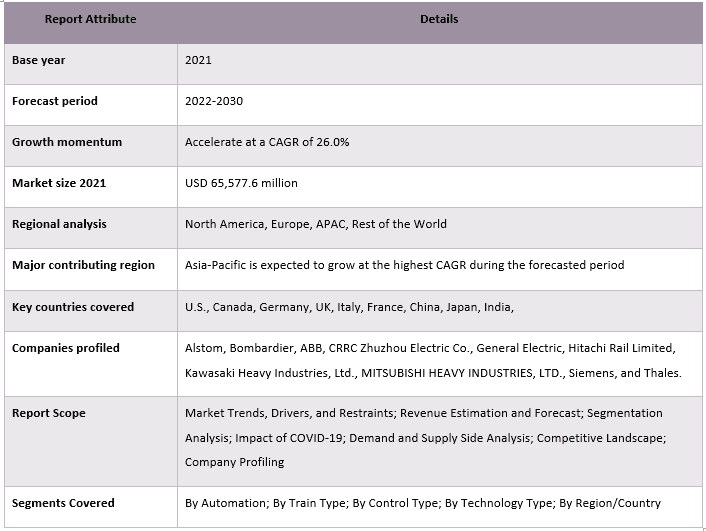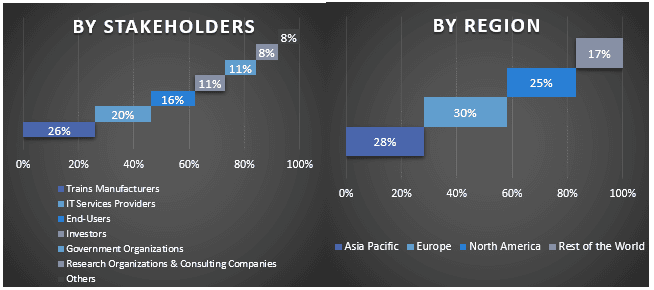- Strona główna
- O nas
- Branża
- Usługi
- Czytanie
- Kontakt
Rynek Technologii Autonomicznych Pociągów: Aktualna Analiza i Prognoza (2022-2030)
Nacisk na automatyzację (Stopień Automatyzacji 1 (GOA 1), Stopień Automatyzacji 2 (GOA 2), Stopień Automatyzacji 3 (GOA 3) i Stopień Automatyzacji 4 (GOA 4)); Rodzaj Technologii (Konwencjonalna i Hybrydowa); Według Rodzaju Sterowania (Communication-Based Train Control (CBTC), European Railway Traffic Management System (ERTMS), Automatic Train Control (ATC) i Positive Train Control (PTC)]); Region/Kraj.

Wartość rynkowa technologii autonomicznych pociągów wynosiła 65 577,6 mln USD w 2021 r. i oczekuje się, że wzrośnie przy CAGR na poziomie 26,0% w latach 2022–2030. Jednym z kluczowych czynników napędzających ten rynek jest rosnące zapotrzebowanie na automatyzację w różnych branżach, w tym w transporcie. Wraz z postępem technologicznym autonomiczne pociągi stają się bardziej wydajne, bezpieczniejsze i bardziej opłacalne niż tradycyjne pociągi. Oczekuje się, że spowoduje to wzrost popularności technologii autonomicznych pociągów w różnych zastosowaniach, takich jak transport towarowy, transport pasażerski i usługi serwisowe.
Kolejnym czynnikiem napędzającym wzrost globalnego rynku technologii autonomicznych pociągów są rosnące inwestycje w infrastrukturę kolejową. Rządy i organizacje prywatne intensywnie inwestują w rozwój szybkich sieci kolejowych, które wymagają zaawansowanej technologii do wydajnej i bezpiecznej eksploatacji. Technologia autonomicznych pociągów może w tym pomóc, poprawiając wydajność transportu kolejowego i zmniejszając ryzyko wypadków.
Ponadto oczekuje się, że globalny rynek technologii autonomicznych pociągów skorzysta na rosnącym trendzie zrównoważonego transportu. Autonomiczne pociągi mogą pomóc w zmniejszeniu emisji gazów cieplarnianych i poprawie efektywności energetycznej, co czyni je atrakcyjną opcją dla firm transportowych i rządów dbających o środowisko.
Na przykład 19 kwietnia 2023 r. firma Alstom została wybrana przez Euro metropolię Strasburga i CTS do dostarczenia nowych tramwajów dla strasburskiej sieci.
Do głównych graczy działających na rynku należą Alstom, Bombardier, ABB, CRRC Zhuzhou Electric Co., General Electric, Hitachi Rail Limited, Kawasaki Heavy Industries, Ltd., MITSUBISHI HEAVY INDUSTRIES, LTD., Siemens i Thales. Gracze ci przeprowadzili szereg fuzji i przejęć oraz nawiązali partnerstwa, aby oferować klientom zaawansowane technologicznie i innowacyjne produkty/technologie.
Informacje przedstawione w raporcie
„Wśród technologii segment hybrydowy odnotuje znaczący wzrost w nadchodzącym okresie prognozy”.
Na podstawie rodzaju technologii rynek jest podzielony na konwencjonalny i hybrydowy. Spośród nich segment inteligentnych urządzeń zdominował rynek w 2021 r. Oczekuje się, że segment hybrydowy odnotuje znaczący wzrost na rynku technologii autonomicznych pociągów ze względu na jego zdolność do łączenia zalet pociągów elektrycznych i spalinowych. Pociągi hybrydowe mogą kursować zarówno po zelektryfikowanych, jak i niezelektryfikowanych torach, zapewniając większą elastyczność i wydajność w ich działaniu. Ponadto pociągi hybrydowe są bardziej przyjazne dla środowiska niż tradycyjne pociągi spalinowe, ponieważ emitują mniej spalin i zużywają mniej paliwa. Te zalety sprawiają, że pociągi hybrydowe są atrakcyjną opcją dla operatorów kolejowych, którzy chcą zmodernizować swoje floty i poprawić ich zrównoważony rozwój.
„Wśród rodzajów pociągów segment pociągów towarowych odnotuje znaczący wzrost w nadchodzącym okresie prognozy”.
Pod względem rodzaju pociągu rynek jest podzielony na pociągi pasażerskie i pociągi towarowe. Spośród nich oczekuje się, że segment pociągów towarowych odnotuje znaczący wzrost na rynku technologii autonomicznych pociągów z kilku powodów. Po pierwsze, autonomiczne pociągi towarowe mogą kursować przez całą dobę, bez potrzeby przerw lub okresów odpoczynku dla operatorów-ludzi. Może to skutkować zwiększoną wydajnością i produktywnością dla firm transportu towarowego, a także obniżeniem kosztów pracy. Po drugie, autonomiczne pociągi towarowe można zaprogramować tak, aby optymalizowały swoją prędkość i trasę na podstawie danych w czasie rzeczywistym i warunków ruchu, co skutkuje szybszymi i bardziej niezawodnymi czasami dostawy. Może to pomóc w poprawie zadowolenia klientów i zwiększeniu konkurencyjności firm transportu towarowego.
„Oczekuje się, że region Azji i Pacyfiku będzie rósł przy najwyższym CAGR w prognozowanym okresie”
Region Azji i Pacyfiku odnotowuje znaczący wzrost na rynku technologii autonomicznych pociągów z kilku powodów. Jednym z głównych powodów jest rosnące zapotrzebowanie na wydajne i niezawodne systemy transportowe w regionie. Wysoka gęstość zaludnienia na wielu obszarach Azji i Pacyfiku doprowadziła do przeludnienia i zatłoczenia w tradycyjnych systemach transportowych, co czyni autonomiczne pociągi atrakcyjnym rozwiązaniem. Ponadto wiele krajów w regionie, takich jak Chiny, Japonia i Korea Południowa, dokonało znaczących inwestycji w rozwój i wdrażanie technologii autonomicznych pociągów. Rosnące wdrażanie zaawansowanych technologii i obecność kluczowych graczy w regionie również przyczyniły się do wzrostu rynku technologii autonomicznych pociągów w regionie Azji i Pacyfiku.
Zakres raportu na temat rynku technologii autonomicznych pociągów

Powody, dla których warto kupić ten raport:
- Badanie obejmuje analizę wielkości rynku i prognozowanie zweryfikowane przez uwierzytelnionych kluczowych ekspertów branżowych.
- Raport przedstawia szybki przegląd ogólnej wydajności branży na pierwszy rzut oka.
- Raport obejmuje dogłębną analizę czołowych podmiotów z branży, z głównym naciskiem na kluczowe dane finansowe przedsiębiorstw, portfele produktów, strategie ekspansji i najnowsze osiągnięcia.
- Szczegółowe badanie czynników napędzających, ograniczeń, kluczowych trendów i możliwości występujących w branży.
- Badanie kompleksowo obejmuje rynek w różnych segmentach.
- Dogłębna analiza branży na poziomie regionalnym.
Opcje dostosowywania:
Globalny rynek technologii autonomicznych pociągów można dodatkowo dostosować do wymagań lub dowolnego innego segmentu rynku. Poza tym UMI rozumie, że możesz mieć własne potrzeby biznesowe, dlatego zachęcamy do kontaktu z nami, aby uzyskać raport, który w pełni odpowiada Twoim wymaganiom.
Spis treści
Metodologia badań dla analizy rynku technologii autonomicznych pociągów
(2022-2030)
Analiza historycznego rynku, szacowanie obecnego rynku i prognozowanie przyszłego rynku globalnego rynku technologii autonomicznych pociągów to trzy główne kroki podjęte w celu stworzenia i analizy adopcji technologii autonomicznych pociągów w głównych regionach na całym świecie. Przeprowadzono wyczerpujące badania wtórne, aby zebrać dane dotyczące historycznego rynku i oszacować obecną wielkość rynku. Po drugie, aby zweryfikować te spostrzeżenia, wzięto pod uwagę liczne ustalenia i założenia. Ponadto przeprowadzono również wyczerpujące wywiady pierwotne z ekspertami branżowymi w całym łańcuchu wartości globalnego rynku technologii autonomicznych pociągów. Po założeniu i walidacji danych rynkowych poprzez wywiady pierwotne, zastosowaliśmy podejście top-down/bottom-up do prognozowania całkowitej wielkości rynku. Następnie przyjęto metody podziału rynku i triangulacji danych w celu oszacowania i analizy wielkości rynku segmentów i podsegmentów dotyczących branży. Szczegółowa metodologia jest wyjaśniona poniżej:
Analiza historycznej wielkości rynku
Krok 1: Dogłębne badanie źródeł wtórnych:
Przeprowadzono szczegółowe badania wtórne w celu uzyskania historycznej wielkości rynku technologii autonomicznych pociągów poprzez wewnętrzne źródła firmowe, takie jak raporty roczne i sprawozdania finansowe, prezentacje wyników, komunikaty prasowe itp., oraz zewnętrzne źródła, w tym czasopisma, wiadomości i artykuły, publikacje rządowe, publikacje konkurencji, raporty sektorowe, bazy danych stron trzecich i inne wiarygodne publikacje.
Krok 2: Segmentacja rynku:
Po uzyskaniu historycznej wielkości rynku technologii autonomicznych pociągów przeprowadziliśmy szczegółową analizę wtórną w celu zebrania historycznych spostrzeżeń rynkowych i udziału dla różnych segmentów i podsegmentów dla głównych regionów. Główne segmenty zawarte w raporcie to produkt, technologia i użytkownicy końcowi. Przeprowadzono dalsze analizy na poziomie krajowym w celu oceny ogólnego wdrożenia modeli testowych w danym regionie.
Krok 3: Analiza czynnikowa:
Po uzyskaniu historycznej wielkości rynku różnych segmentów i podsegmentów przeprowadziliśmy szczegółową analizę czynnikową w celu oszacowania obecnej wielkości rynku technologii autonomicznych pociągów. Ponadto przeprowadziliśmy analizę czynnikową przy użyciu zmiennych zależnych i niezależnych, takich jak produkt, technologia i użytkownicy końcowi rynku technologii autonomicznych pociągów. Przeprowadzono dogłębną analizę scenariuszy popytu i podaży, biorąc pod uwagę najważniejsze partnerstwa, fuzje i przejęcia, ekspansję biznesową i wprowadzanie produktów na rynek w sektorze technologii autonomicznych pociągów na całym świecie.
Szacunek bieżącej wielkości rynku i prognoza
Bieżące określanie wielkości rynku: W oparciu o praktyczne spostrzeżenia z powyższych 3 kroków doszliśmy do obecnej wielkości rynku, kluczowych graczy na globalnym rynku technologii autonomicznych pociągów oraz udziałów rynkowych segmentów. Wszystkie wymagane udziały procentowe i podziały rynkowe zostały określone przy użyciu wspomnianego powyżej podejścia wtórnego i zostały zweryfikowane poprzez wywiady pierwotne.
Szacowanie i prognozowanie: Do oszacowania i prognozowania rynku przypisano wagi różnym czynnikom, w tym czynnikom napędzającym i trendom, ograniczeniom i możliwościom dostępnym dla interesariuszy. Po przeanalizowaniu tych czynników zastosowano odpowiednie techniki prognozowania, tj. podejście top-down/bottom-up, aby dojść do prognozy rynkowej na rok 2028 dla różnych segmentów i podsegmentów na głównych rynkach na całym świecie. Metodologia badań przyjęta do oszacowania wielkości rynku obejmuje:
- Wielkość rynku branży pod względem przychodów (USD) i wskaźnik adopcji rynku technologii autonomicznych pociągów na głównych rynkach krajowych
- Wszystkie udziały procentowe, podziały i rozbicia segmentów i podsegmentów rynku
- Kluczowi gracze na globalnym rynku technologii autonomicznych pociągów pod względem oferowanych produktów. Ponadto strategie wzrostu przyjęte przez tych graczy w celu konkurowania na szybko rozwijającym się rynku
Walidacja wielkości i udziału w rynku
Badania pierwotne: Przeprowadzono dogłębne wywiady z kluczowymi liderami opinii (KOL), w tym z kadrą kierowniczą najwyższego szczebla (CXO/VP, szef sprzedaży, szef marketingu, szef operacyjny, szef regionalny, szef krajowy itp.) w głównych regionach. Następnie podsumowano wyniki badań pierwotnych i przeprowadzono analizę statystyczną w celu udowodnienia postawionej hipotezy. Dane wejściowe z badań pierwotnych zostały skonsolidowane z wynikami badań wtórnych, przekształcając w ten sposób informacje w praktyczne spostrzeżenia.
Podział uczestników badań pierwotnych w różnych regionach

Inżynieria rynku
Zastosowano technikę triangulacji danych, aby ukończyć ogólne szacowanie rynku i dojść do precyzyjnych danych statystycznych dla każdego segmentu i podsegmentu globalnego rynku technologii autonomicznych pociągów. Dane podzielono na kilka segmentów i podsegmentów po przestudiowaniu różnych parametrów i trendów w obszarach produktu, s
Główny cel badania globalnego rynku technologii autonomicznych pociągów
W badaniu wskazano obecne i przyszłe trendy rynkowe globalnego rynku technologii autonomicznych pociągów. Inwestorzy mogą uzyskać strategiczne spostrzeżenia, na których mogą oprzeć swoją decyzję o inwestycjach, na podstawie analizy jakościowej i ilościowej przeprowadzonej w badaniu. Obecne i przyszłe trendy rynkowe określiły ogólną atrakcyjność rynku na poziomie regionalnym, zapewniając uczestnikom przemysłowym platformę do wykorzystania niezbadanego rynku w celu czerpania korzyści z przewagi pioniera. Inne ilościowe cele badań obejmują:
- Analiza obecnej i prognozowanej wielkości rynku technologii autonomicznych pociągów pod względem wartości (USD). Ponadto analiza obecnej i prognozowanej wielkości rynku różnych segmentów i podsegmentów.
- Segmenty w badaniu obejmują obszary typu pociągu, typu technologii, typu sterowania i automatyzacji
- Definiowanie i analiza ram regulacyjnych dla branży technologii autonomicznych pociągów
- Analiza łańcucha wartości związanego z obecnością różnych pośredników, wraz z analizą zachowań klientów i konkurentów w branży
- Analiza obecnej i prognozowanej wielkości rynku technologii autonomicznych pociągów dla głównego regionu
- Główne kraje regionów badanych w raporcie to Azja i Pacyfik, Europa, Ameryka Północna i reszta świata
- Profile firm z rynku technologii autonomicznych pociągów i strategie wzrostu przyjęte przez uczestników rynku w celu utrzymania się na szybko rozwijającym się rynku
- Dogłębna analiza branży na poziomie regionalnym
Powiązane Raporty
Klienci, którzy kupili ten przedmiot, kupili również










